Effective Disaster Management Needs in Climate Change: India
VerifiedAdded on 2023/05/31
|8
|1564
|379
Report
AI Summary
This report examines the critical need for adaptive disaster management in India, particularly in the context of climate-related disasters. It begins by establishing the background of natural disasters and their increasing frequency and intensity due to factors like anthropogenic climate change and unplanned urbanization. The report highlights the importance of aligning disaster management strategies with climate factors, referencing the International Strategy for Disaster Reduction and the Sendai Framework for Action. It emphasizes proactive problem identification, cross-border issue avoidance, and preparedness for emergencies. The rationale underscores the knowledge gap among professionals in India regarding effective disaster management, aiming to reduce the loss of lives and economic impact caused by disasters. The research objectives include studying India's disaster management background, identifying loopholes, and suggesting improvements. Methods include comparing existing and proposed strategies, recommending improvements, and identifying necessary resources, with a detailed activity timeline provided for project execution. The report concludes by emphasizing the role of government in disaster management, and the importance of disaster management to preserve and protect the maximum number of lives as well as property when a natural disaster takes place, especially for a country as vulnerable as India.
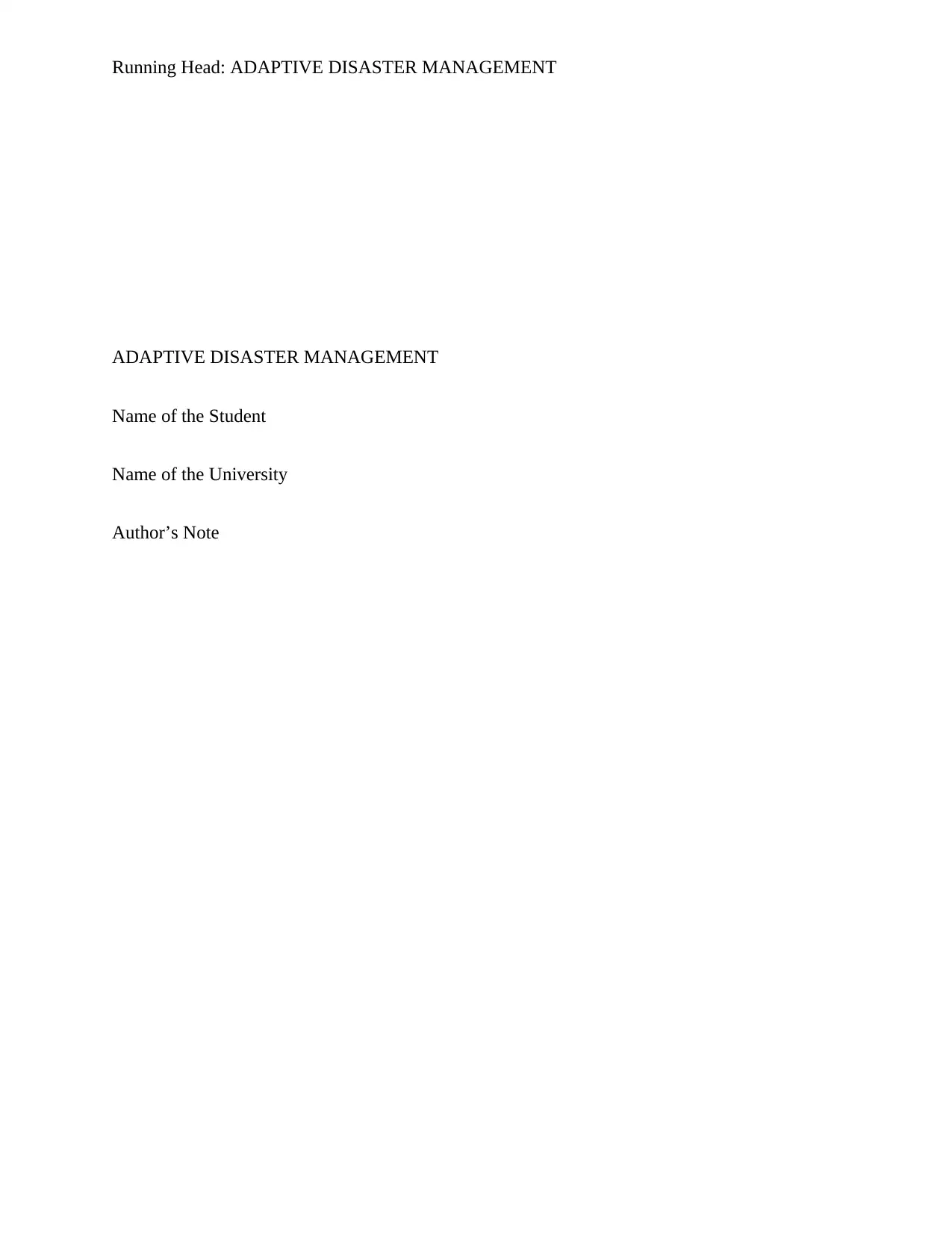
Running Head: ADAPTIVE DISASTER MANAGEMENT
ADAPTIVE DISASTER MANAGEMENT
Name of the Student
Name of the University
Author’s Note
ADAPTIVE DISASTER MANAGEMENT
Name of the Student
Name of the University
Author’s Note
Paraphrase This Document
Need a fresh take? Get an instant paraphrase of this document with our AI Paraphraser
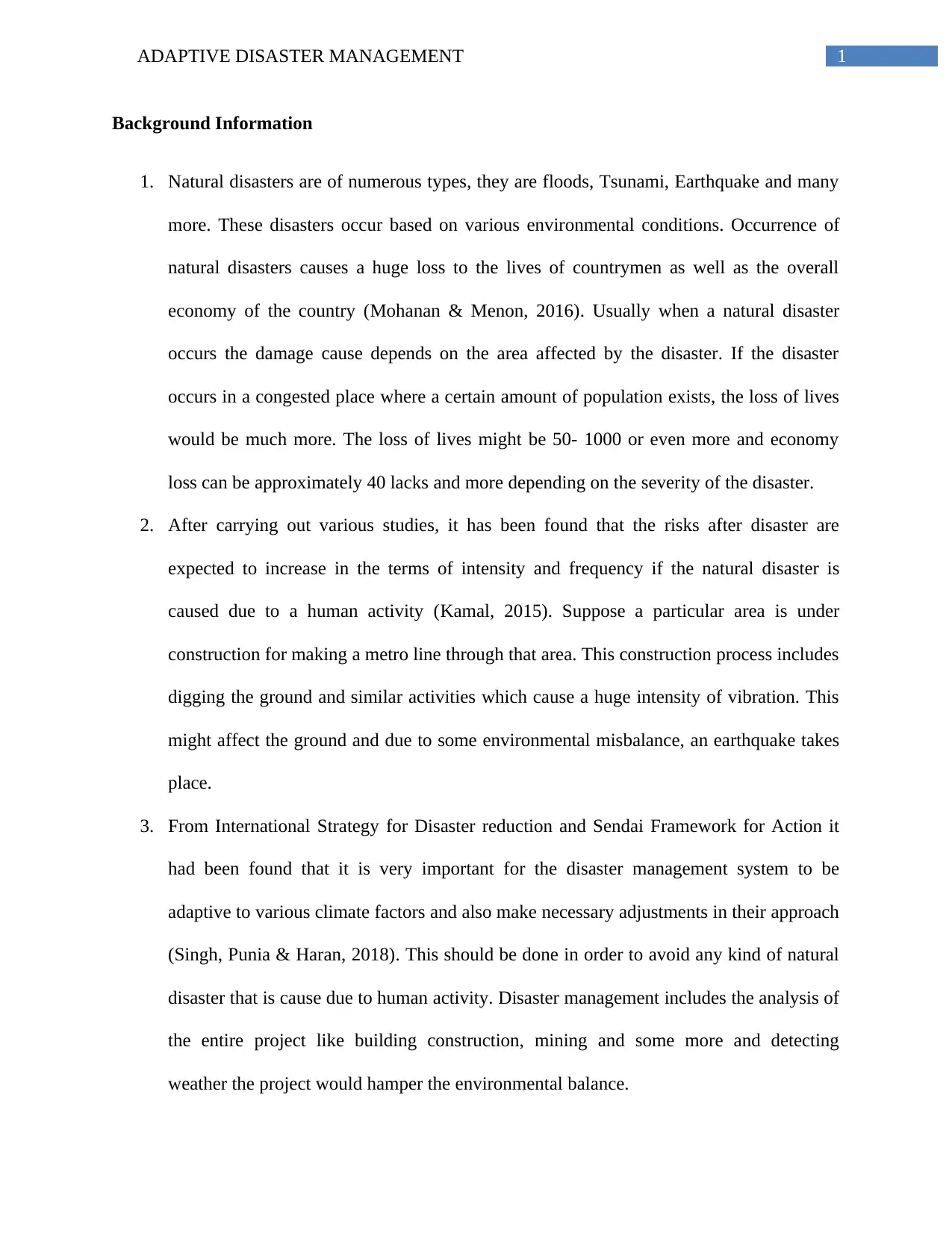
1ADAPTIVE DISASTER MANAGEMENT
Background Information
1. Natural disasters are of numerous types, they are floods, Tsunami, Earthquake and many
more. These disasters occur based on various environmental conditions. Occurrence of
natural disasters causes a huge loss to the lives of countrymen as well as the overall
economy of the country (Mohanan & Menon, 2016). Usually when a natural disaster
occurs the damage cause depends on the area affected by the disaster. If the disaster
occurs in a congested place where a certain amount of population exists, the loss of lives
would be much more. The loss of lives might be 50- 1000 or even more and economy
loss can be approximately 40 lacks and more depending on the severity of the disaster.
2. After carrying out various studies, it has been found that the risks after disaster are
expected to increase in the terms of intensity and frequency if the natural disaster is
caused due to a human activity (Kamal, 2015). Suppose a particular area is under
construction for making a metro line through that area. This construction process includes
digging the ground and similar activities which cause a huge intensity of vibration. This
might affect the ground and due to some environmental misbalance, an earthquake takes
place.
3. From International Strategy for Disaster reduction and Sendai Framework for Action it
had been found that it is very important for the disaster management system to be
adaptive to various climate factors and also make necessary adjustments in their approach
(Singh, Punia & Haran, 2018). This should be done in order to avoid any kind of natural
disaster that is cause due to human activity. Disaster management includes the analysis of
the entire project like building construction, mining and some more and detecting
weather the project would hamper the environmental balance.
Background Information
1. Natural disasters are of numerous types, they are floods, Tsunami, Earthquake and many
more. These disasters occur based on various environmental conditions. Occurrence of
natural disasters causes a huge loss to the lives of countrymen as well as the overall
economy of the country (Mohanan & Menon, 2016). Usually when a natural disaster
occurs the damage cause depends on the area affected by the disaster. If the disaster
occurs in a congested place where a certain amount of population exists, the loss of lives
would be much more. The loss of lives might be 50- 1000 or even more and economy
loss can be approximately 40 lacks and more depending on the severity of the disaster.
2. After carrying out various studies, it has been found that the risks after disaster are
expected to increase in the terms of intensity and frequency if the natural disaster is
caused due to a human activity (Kamal, 2015). Suppose a particular area is under
construction for making a metro line through that area. This construction process includes
digging the ground and similar activities which cause a huge intensity of vibration. This
might affect the ground and due to some environmental misbalance, an earthquake takes
place.
3. From International Strategy for Disaster reduction and Sendai Framework for Action it
had been found that it is very important for the disaster management system to be
adaptive to various climate factors and also make necessary adjustments in their approach
(Singh, Punia & Haran, 2018). This should be done in order to avoid any kind of natural
disaster that is cause due to human activity. Disaster management includes the analysis of
the entire project like building construction, mining and some more and detecting
weather the project would hamper the environmental balance.
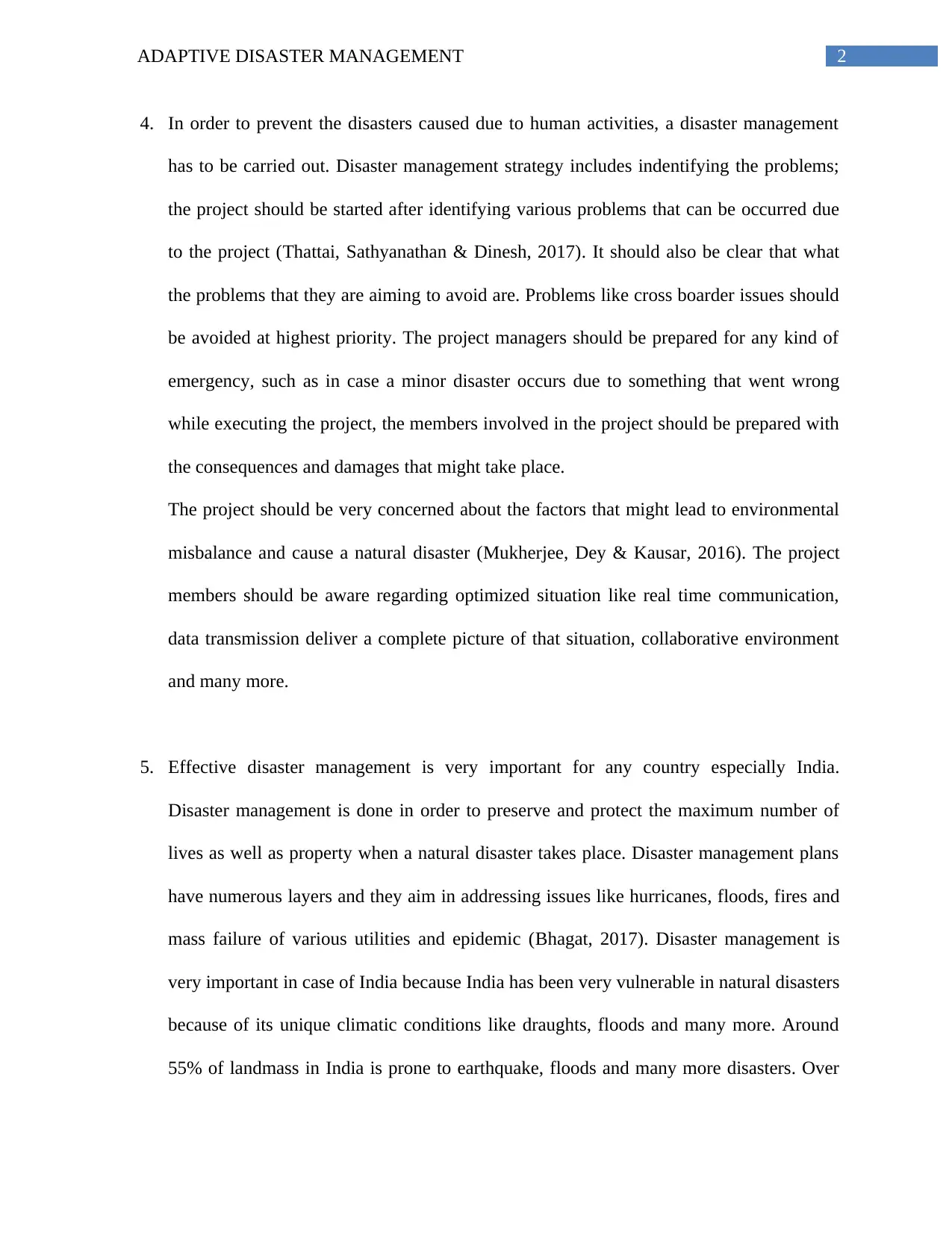
2ADAPTIVE DISASTER MANAGEMENT
4. In order to prevent the disasters caused due to human activities, a disaster management
has to be carried out. Disaster management strategy includes indentifying the problems;
the project should be started after identifying various problems that can be occurred due
to the project (Thattai, Sathyanathan & Dinesh, 2017). It should also be clear that what
the problems that they are aiming to avoid are. Problems like cross boarder issues should
be avoided at highest priority. The project managers should be prepared for any kind of
emergency, such as in case a minor disaster occurs due to something that went wrong
while executing the project, the members involved in the project should be prepared with
the consequences and damages that might take place.
The project should be very concerned about the factors that might lead to environmental
misbalance and cause a natural disaster (Mukherjee, Dey & Kausar, 2016). The project
members should be aware regarding optimized situation like real time communication,
data transmission deliver a complete picture of that situation, collaborative environment
and many more.
5. Effective disaster management is very important for any country especially India.
Disaster management is done in order to preserve and protect the maximum number of
lives as well as property when a natural disaster takes place. Disaster management plans
have numerous layers and they aim in addressing issues like hurricanes, floods, fires and
mass failure of various utilities and epidemic (Bhagat, 2017). Disaster management is
very important in case of India because India has been very vulnerable in natural disasters
because of its unique climatic conditions like draughts, floods and many more. Around
55% of landmass in India is prone to earthquake, floods and many more disasters. Over
4. In order to prevent the disasters caused due to human activities, a disaster management
has to be carried out. Disaster management strategy includes indentifying the problems;
the project should be started after identifying various problems that can be occurred due
to the project (Thattai, Sathyanathan & Dinesh, 2017). It should also be clear that what
the problems that they are aiming to avoid are. Problems like cross boarder issues should
be avoided at highest priority. The project managers should be prepared for any kind of
emergency, such as in case a minor disaster occurs due to something that went wrong
while executing the project, the members involved in the project should be prepared with
the consequences and damages that might take place.
The project should be very concerned about the factors that might lead to environmental
misbalance and cause a natural disaster (Mukherjee, Dey & Kausar, 2016). The project
members should be aware regarding optimized situation like real time communication,
data transmission deliver a complete picture of that situation, collaborative environment
and many more.
5. Effective disaster management is very important for any country especially India.
Disaster management is done in order to preserve and protect the maximum number of
lives as well as property when a natural disaster takes place. Disaster management plans
have numerous layers and they aim in addressing issues like hurricanes, floods, fires and
mass failure of various utilities and epidemic (Bhagat, 2017). Disaster management is
very important in case of India because India has been very vulnerable in natural disasters
because of its unique climatic conditions like draughts, floods and many more. Around
55% of landmass in India is prone to earthquake, floods and many more disasters. Over
⊘ This is a preview!⊘
Do you want full access?
Subscribe today to unlock all pages.

Trusted by 1+ million students worldwide
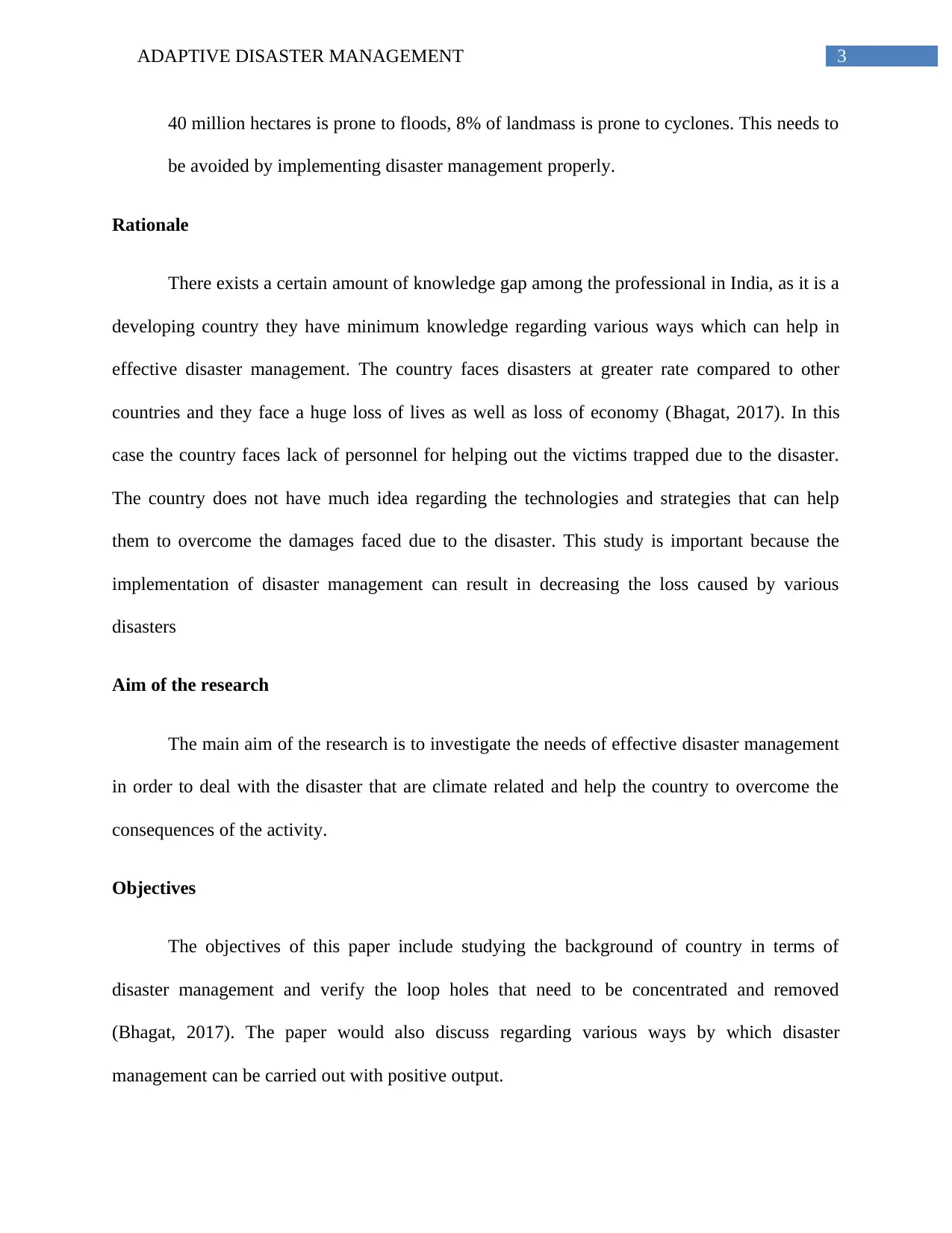
3ADAPTIVE DISASTER MANAGEMENT
40 million hectares is prone to floods, 8% of landmass is prone to cyclones. This needs to
be avoided by implementing disaster management properly.
Rationale
There exists a certain amount of knowledge gap among the professional in India, as it is a
developing country they have minimum knowledge regarding various ways which can help in
effective disaster management. The country faces disasters at greater rate compared to other
countries and they face a huge loss of lives as well as loss of economy (Bhagat, 2017). In this
case the country faces lack of personnel for helping out the victims trapped due to the disaster.
The country does not have much idea regarding the technologies and strategies that can help
them to overcome the damages faced due to the disaster. This study is important because the
implementation of disaster management can result in decreasing the loss caused by various
disasters
Aim of the research
The main aim of the research is to investigate the needs of effective disaster management
in order to deal with the disaster that are climate related and help the country to overcome the
consequences of the activity.
Objectives
The objectives of this paper include studying the background of country in terms of
disaster management and verify the loop holes that need to be concentrated and removed
(Bhagat, 2017). The paper would also discuss regarding various ways by which disaster
management can be carried out with positive output.
40 million hectares is prone to floods, 8% of landmass is prone to cyclones. This needs to
be avoided by implementing disaster management properly.
Rationale
There exists a certain amount of knowledge gap among the professional in India, as it is a
developing country they have minimum knowledge regarding various ways which can help in
effective disaster management. The country faces disasters at greater rate compared to other
countries and they face a huge loss of lives as well as loss of economy (Bhagat, 2017). In this
case the country faces lack of personnel for helping out the victims trapped due to the disaster.
The country does not have much idea regarding the technologies and strategies that can help
them to overcome the damages faced due to the disaster. This study is important because the
implementation of disaster management can result in decreasing the loss caused by various
disasters
Aim of the research
The main aim of the research is to investigate the needs of effective disaster management
in order to deal with the disaster that are climate related and help the country to overcome the
consequences of the activity.
Objectives
The objectives of this paper include studying the background of country in terms of
disaster management and verify the loop holes that need to be concentrated and removed
(Bhagat, 2017). The paper would also discuss regarding various ways by which disaster
management can be carried out with positive output.
Paraphrase This Document
Need a fresh take? Get an instant paraphrase of this document with our AI Paraphraser
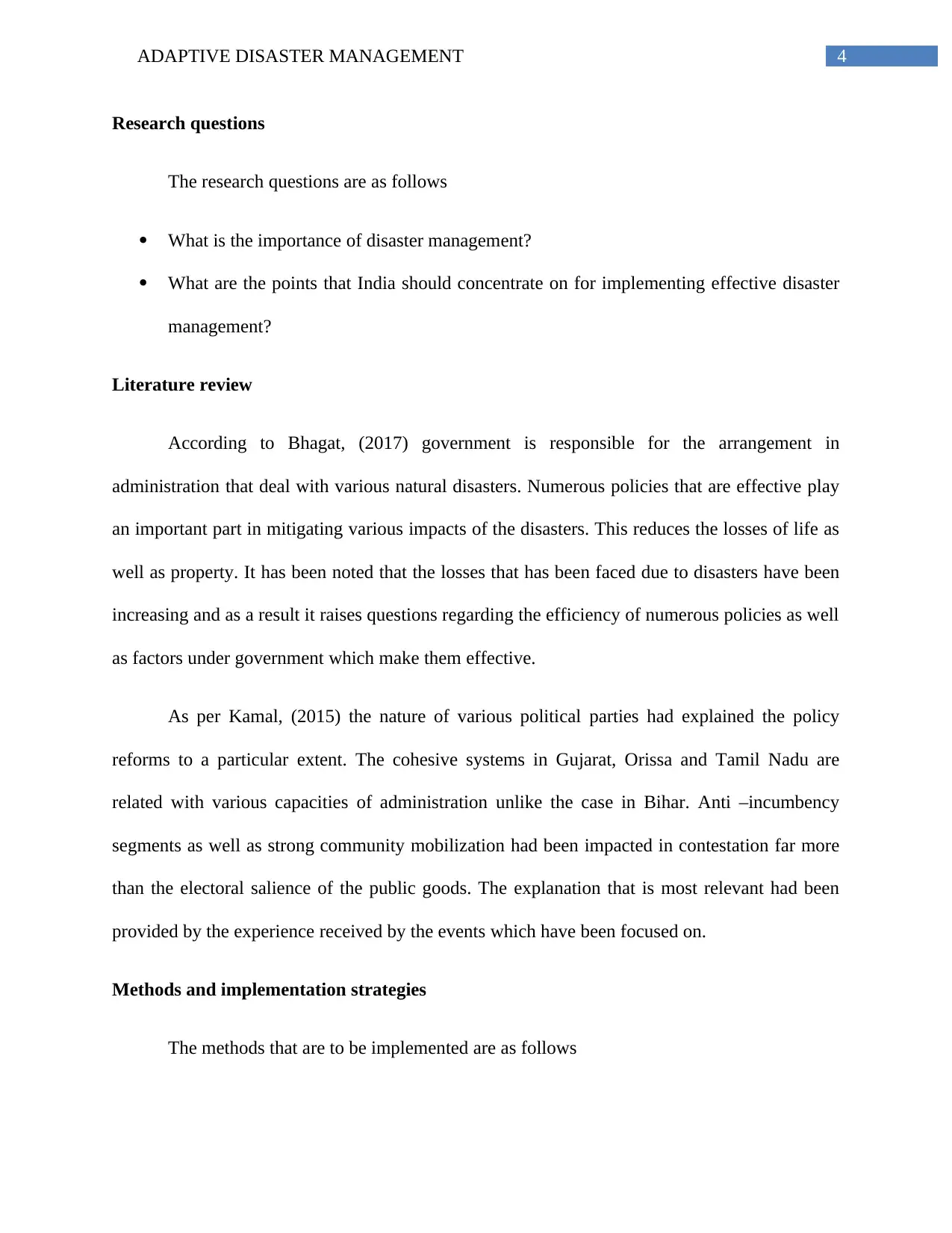
4ADAPTIVE DISASTER MANAGEMENT
Research questions
The research questions are as follows
What is the importance of disaster management?
What are the points that India should concentrate on for implementing effective disaster
management?
Literature review
According to Bhagat, (2017) government is responsible for the arrangement in
administration that deal with various natural disasters. Numerous policies that are effective play
an important part in mitigating various impacts of the disasters. This reduces the losses of life as
well as property. It has been noted that the losses that has been faced due to disasters have been
increasing and as a result it raises questions regarding the efficiency of numerous policies as well
as factors under government which make them effective.
As per Kamal, (2015) the nature of various political parties had explained the policy
reforms to a particular extent. The cohesive systems in Gujarat, Orissa and Tamil Nadu are
related with various capacities of administration unlike the case in Bihar. Anti –incumbency
segments as well as strong community mobilization had been impacted in contestation far more
than the electoral salience of the public goods. The explanation that is most relevant had been
provided by the experience received by the events which have been focused on.
Methods and implementation strategies
The methods that are to be implemented are as follows
Research questions
The research questions are as follows
What is the importance of disaster management?
What are the points that India should concentrate on for implementing effective disaster
management?
Literature review
According to Bhagat, (2017) government is responsible for the arrangement in
administration that deal with various natural disasters. Numerous policies that are effective play
an important part in mitigating various impacts of the disasters. This reduces the losses of life as
well as property. It has been noted that the losses that has been faced due to disasters have been
increasing and as a result it raises questions regarding the efficiency of numerous policies as well
as factors under government which make them effective.
As per Kamal, (2015) the nature of various political parties had explained the policy
reforms to a particular extent. The cohesive systems in Gujarat, Orissa and Tamil Nadu are
related with various capacities of administration unlike the case in Bihar. Anti –incumbency
segments as well as strong community mobilization had been impacted in contestation far more
than the electoral salience of the public goods. The explanation that is most relevant had been
provided by the experience received by the events which have been focused on.
Methods and implementation strategies
The methods that are to be implemented are as follows
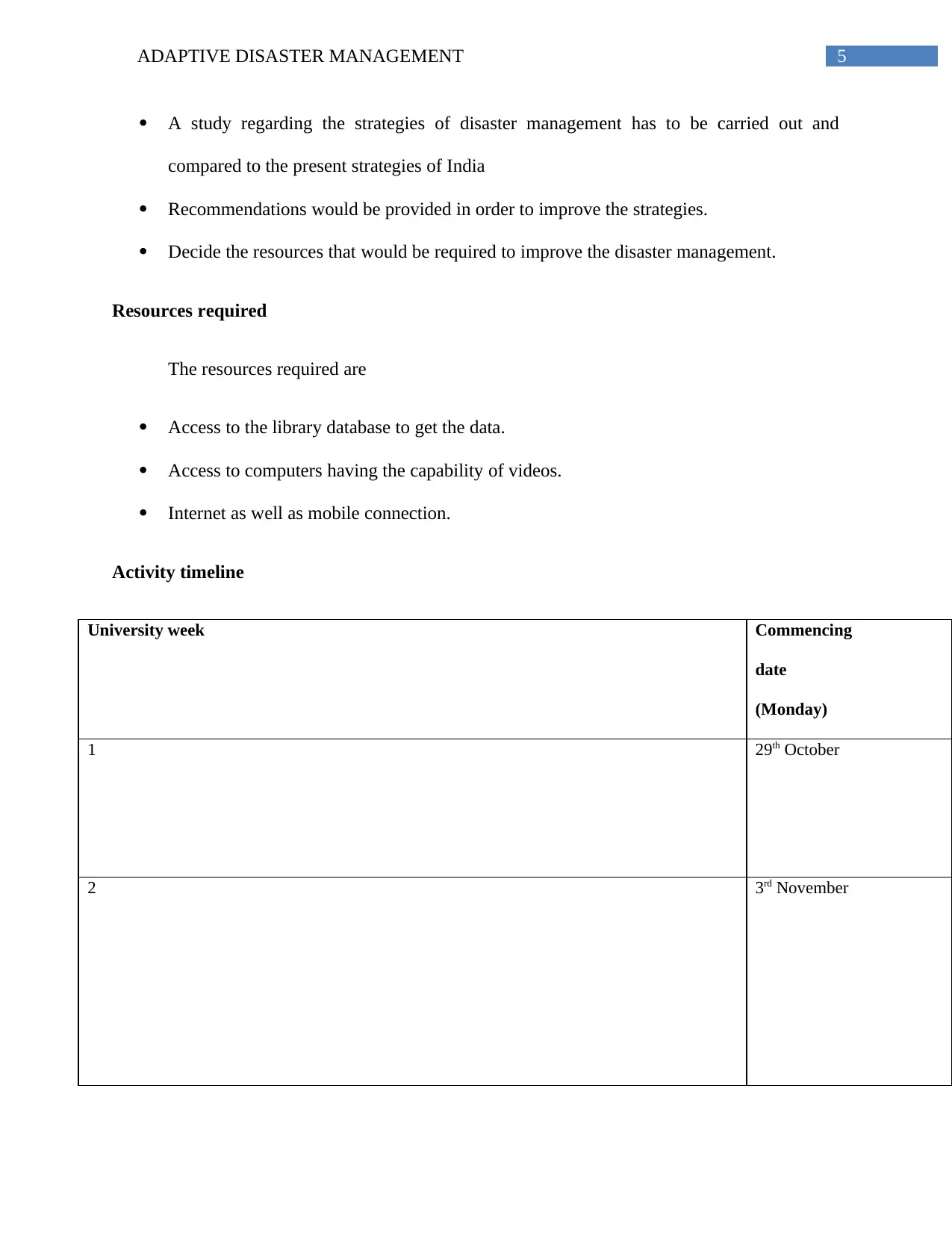
5ADAPTIVE DISASTER MANAGEMENT
A study regarding the strategies of disaster management has to be carried out and
compared to the present strategies of India
Recommendations would be provided in order to improve the strategies.
Decide the resources that would be required to improve the disaster management.
Resources required
The resources required are
Access to the library database to get the data.
Access to computers having the capability of videos.
Internet as well as mobile connection.
Activity timeline
University week Commencing
date
(Monday)
1 29th October
2 3rd November
A study regarding the strategies of disaster management has to be carried out and
compared to the present strategies of India
Recommendations would be provided in order to improve the strategies.
Decide the resources that would be required to improve the disaster management.
Resources required
The resources required are
Access to the library database to get the data.
Access to computers having the capability of videos.
Internet as well as mobile connection.
Activity timeline
University week Commencing
date
(Monday)
1 29th October
2 3rd November
⊘ This is a preview!⊘
Do you want full access?
Subscribe today to unlock all pages.

Trusted by 1+ million students worldwide
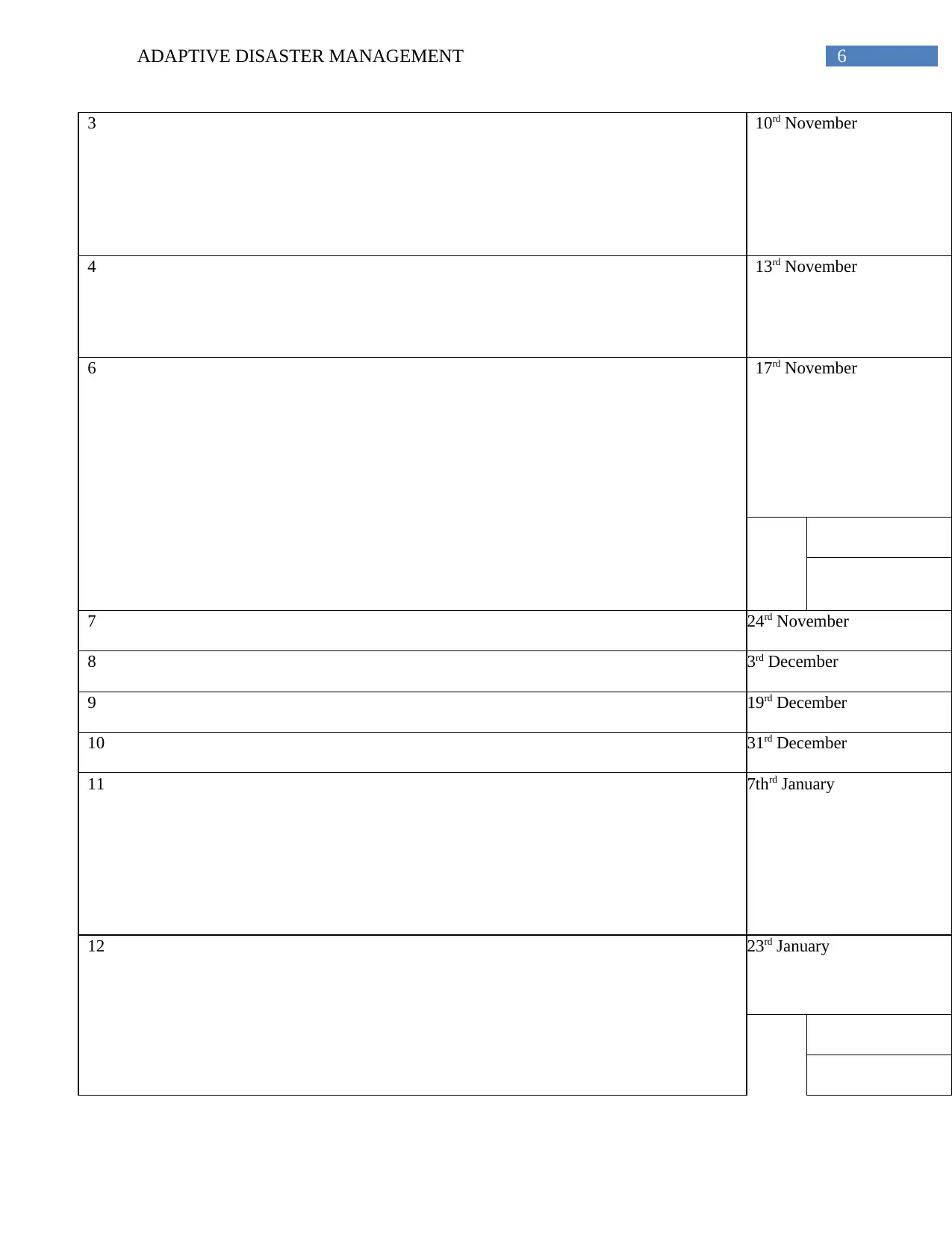
6ADAPTIVE DISASTER MANAGEMENT
3 10rd November
4 13rd November
6 17rd November
7 24rd November
8 3rd December
9 19rd December
10 31rd December
11 7thrd January
12 23rd January
3 10rd November
4 13rd November
6 17rd November
7 24rd November
8 3rd December
9 19rd December
10 31rd December
11 7thrd January
12 23rd January
Paraphrase This Document
Need a fresh take? Get an instant paraphrase of this document with our AI Paraphraser
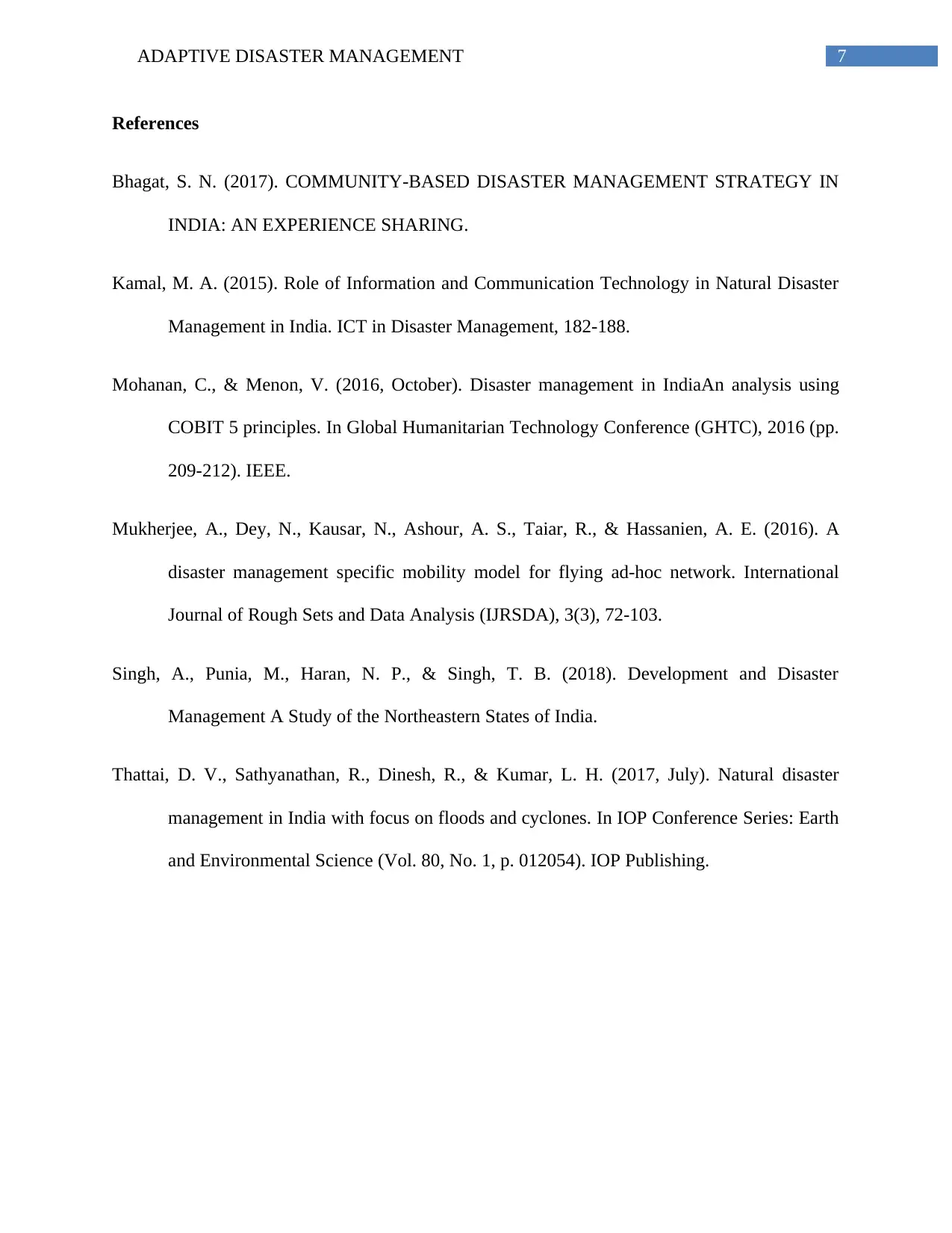
7ADAPTIVE DISASTER MANAGEMENT
References
Bhagat, S. N. (2017). COMMUNITY-BASED DISASTER MANAGEMENT STRATEGY IN
INDIA: AN EXPERIENCE SHARING.
Kamal, M. A. (2015). Role of Information and Communication Technology in Natural Disaster
Management in India. ICT in Disaster Management, 182-188.
Mohanan, C., & Menon, V. (2016, October). Disaster management in IndiaAn analysis using
COBIT 5 principles. In Global Humanitarian Technology Conference (GHTC), 2016 (pp.
209-212). IEEE.
Mukherjee, A., Dey, N., Kausar, N., Ashour, A. S., Taiar, R., & Hassanien, A. E. (2016). A
disaster management specific mobility model for flying ad-hoc network. International
Journal of Rough Sets and Data Analysis (IJRSDA), 3(3), 72-103.
Singh, A., Punia, M., Haran, N. P., & Singh, T. B. (2018). Development and Disaster
Management A Study of the Northeastern States of India.
Thattai, D. V., Sathyanathan, R., Dinesh, R., & Kumar, L. H. (2017, July). Natural disaster
management in India with focus on floods and cyclones. In IOP Conference Series: Earth
and Environmental Science (Vol. 80, No. 1, p. 012054). IOP Publishing.
References
Bhagat, S. N. (2017). COMMUNITY-BASED DISASTER MANAGEMENT STRATEGY IN
INDIA: AN EXPERIENCE SHARING.
Kamal, M. A. (2015). Role of Information and Communication Technology in Natural Disaster
Management in India. ICT in Disaster Management, 182-188.
Mohanan, C., & Menon, V. (2016, October). Disaster management in IndiaAn analysis using
COBIT 5 principles. In Global Humanitarian Technology Conference (GHTC), 2016 (pp.
209-212). IEEE.
Mukherjee, A., Dey, N., Kausar, N., Ashour, A. S., Taiar, R., & Hassanien, A. E. (2016). A
disaster management specific mobility model for flying ad-hoc network. International
Journal of Rough Sets and Data Analysis (IJRSDA), 3(3), 72-103.
Singh, A., Punia, M., Haran, N. P., & Singh, T. B. (2018). Development and Disaster
Management A Study of the Northeastern States of India.
Thattai, D. V., Sathyanathan, R., Dinesh, R., & Kumar, L. H. (2017, July). Natural disaster
management in India with focus on floods and cyclones. In IOP Conference Series: Earth
and Environmental Science (Vol. 80, No. 1, p. 012054). IOP Publishing.
1 out of 8
Related Documents
Your All-in-One AI-Powered Toolkit for Academic Success.
+13062052269
info@desklib.com
Available 24*7 on WhatsApp / Email
![[object Object]](/_next/static/media/star-bottom.7253800d.svg)
Unlock your academic potential
Copyright © 2020–2025 A2Z Services. All Rights Reserved. Developed and managed by ZUCOL.




